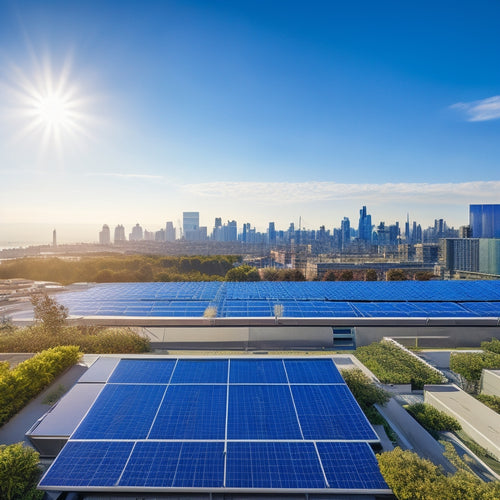
Solar Panel Systems to Consider Buying for Home
Share
When buying a solar panel system for your home, you'll want to contemplate top brands like SunPower, Panasonic, and Tesla, and research their product reviews and warranties. Assess your energy needs and roof compatibility to determine the ideal system size and configuration. Evaluate the system's efficiency and performance metrics, such as energy output rating, module efficiency rate, and power generation capacity. You'll also need to choose an inverter type, either string or micro, and take into account factors like upfront costs, financing options, and tax incentives. As you investigate your options, it's important to weigh the pros and cons of each system to find the one that best fits your needs and budget, and that's just the beginning of your decision-making process.
Key Takeaways
- Research top solar panel brands like SunPower, Panasonic, and Tesla for performance, durability, and warranty.
- Determine the right system size and configuration based on energy needs, roof size, and module layout.
- Evaluate efficiency and performance metrics, including energy output rating, module efficiency rate, and power generation capacity.
- Consider inverter types, such as string or micro inverters, based on system requirements and individual panel optimization needs.
- Look for comprehensive warranties, customer support, and maintenance options to ensure optimal system performance and longevity.
Top Brands to Consider
When it comes to investing in a solar panel system for your home, selecting a reputable brand is vital for ensuring ideal performance, durability, and return on investment. You want a brand that has a proven track record of providing high-quality products and reliable customer support.
To make an informed decision, it's important to conduct a detailed brand comparison. Research top brands like SunPower, Panasonic, and Tesla, and read product reviews from reputable sources like EnergySage and SolarReviews.
Look for brands with high-efficiency panels, durable materials, and extensive warranties. Pay attention to the brand's installation partner network, as this can impact the quality of the installation and maintenance services.
Additionally, consider the brand's customer service and support, as well as its commitment to innovation and sustainability. By conducting a detailed brand comparison and reading product reviews, you can make an informed decision and choose a solar panel system that meets your energy needs and budget.
System Size and Configuration
With your solar panel brand selected, it's time to determine the ideal system size and configuration for your home. This decision depends on several factors, including your energy needs, roof size, and local building codes.
| System Configuration Considerations | Key Factors to Keep in Mind |
|---|---|
| System Orientation | Consider the direction your roof faces (south, east, west, or north) to maximize energy production. |
| Roof Compatibility | Assess your roof's size, shape, and material to determine the best system size and layout. |
| System Size | Calculate your energy needs based on your electricity bills and the system's wattage output. |
| Module Layout | Decide on the number of modules and their arrangement to achieve the desired system size and efficiency. |
Remember to consult with a professional solar installer to confirm your system is properly sized and configured for peak performance. They will assess your unique situation and provide personalized recommendations for your solar panel system.
Efficiency and Performance Metrics
You'll want to evaluate your solar panel system's performance using key metrics, including its energy output rating, which indicates the system's maximum potential production.
The module efficiency rate is another vital factor, as it measures the percentage of sunlight that's converted into electricity.
Additionally, you'll need to take into account the system's power generation capacity, which affects how much electricity it can produce during peak sunlight hours.
Energy Output Rating
Measuring the energy output of a solar panel system is essential to understanding its efficiency and performance. You want to verify that the system you choose can generate the power you need to meet your energy requirements.
When evaluating energy output, consider the following key factors:
-
Peak Sun Hours (PSH): This measures the amount of solar energy available at a specific location. You'll want a system that can maximize energy output during peak sun hours.
-
Maximum Power Point (MPP): This is the point at which a solar panel system produces its maximum power output. Look for a system with a high MPP to verify ideal energy production.
-
Power Temperature Coefficient (PTC): This measures how well a system performs in hot temperatures. A lower PTC rating indicates a system that can maintain its energy output even in extreme heat.
Module Efficiency Rate
When evaluating solar panel systems, understanding energy output is only half the story - you also need to contemplate how efficiently the system converts sunlight into electricity. This is where the module efficiency rate comes in, a critical metric that gauges how well a solar panel system utilizes the sun's energy. Fundamentally, it's the percentage of sunlight that's converted into electrical energy.
A higher module efficiency rate means more power per unit area, which translates to more savings on your energy bill. Currently, the average module efficiency rate for commercial solar panels ranges from 15% to 20%.
However, innovative solar technology and photovoltaic advancements have pushed the boundaries, with some high-efficiency panels boasting rates as high as 23% or more. When comparing solar panel systems, look for modules with higher efficiency rates to maximize your energy yield.
Keep in mind that while higher efficiency often comes at a higher cost, it can lead to greater long-term savings and a faster return on investment.
Power Generation Capacity
With your solar panel system in place, the next critical aspect to review is its power generation capacity, which is a direct reflection of its efficiency and performance.
This capacity determines how well your system can meet your energy demands. You want to verify that your system can generate enough power to cover your daily energy needs.
When evaluating power generation capacity, consider the following key factors:
-
Peak Sun Hours (PSH): The amount of energy your system can produce during peak sunlight hours, typically between 9 am and 3 pm.
-
System Sizing: The size of your system, measured in watts (W), which affects its ability to meet your energy demands.
-
Local Incentives: Check if your local government offers incentives for installing solar panels, such as tax credits or rebates, which can impact your system's overall performance and cost-effectiveness.
Inverter Types and Choices
You'll need to choose an inverter type that suits your solar panel system's requirements.
String inverters, which connect multiple panels in a series, are a popular choice, but micro inverters, which attach to individual panels, offer greater flexibility and monitoring capabilities.
When selecting an inverter, you'll need to evaluate factors such as system size, panel configuration, and monitoring requirements to guarantee peak performance.
String Inverters
Your solar panel system's heart is the inverter, responsible for converting DC power from the panels into AC power for your home's electrical grid. String inverters are one of the most common types of inverters used in residential solar panel systems. They work by connecting multiple solar panels in a string to the inverter, which then converts the DC power into AC power.
Here are some key points to take into account when it comes to string inverters:
-
Advantages: String inverters are generally more cost-effective than other inverter types, making them a more affordable option for homeowners. They're also relatively easy to install and maintain. Additionally, string inverters often come with monitoring capabilities, allowing you to track your system's performance.
-
Disadvantages: One major drawback of string inverters is that if one panel in the string is shaded or malfunctioning, it can affect the performance of the entire string. This can lead to reduced energy production and lower system efficiency.
Another disadvantage is that string inverters typically have a higher voltage rating, which can increase the risk of electrical shock.
Micro Inverters
Approximately 20% of residential solar panel systems employ micro inverters, which offer an alternative to traditional string inverters. As you consider your solar panel system, you'll want to weigh the micro inverter advantages and disadvantages.
On the plus side, micro inverters provide individual panel optimization, allowing each panel to operate independently and maximizing energy production. This is particularly beneficial in scenarios with partial shading or uneven panel performance. Micro inverters also offer real-time monitoring and fault detection at the panel level, making it easier to identify and address issues.
However, micro inverter disadvantages include higher upfront costs compared to traditional string inverters. Additionally, micro inverters can be more complex to install and may require more maintenance due to the increased number of components.
Moreover, some micro inverter systems can be less efficient than string inverters during periods of high energy production. As you evaluate micro inverters for your home solar panel system, carefully consider these trade-offs to determine if the benefits outweigh the drawbacks for your specific needs.
Installation and Maintenance Costs
As solar panel systems become a more viable option for homeowners, understanding the installation and maintenance costs is crucial to making an informed decision.
You'll want to take into account the upfront costs, which can range from $15,000 to $30,000 or more, depending on the size and complexity of the system. However, you can offset these costs with financing options, such as loans or power purchase agreements, and tax incentives, like the Solar Investment Tax Credit (ITC).
Additionally, you'll need to factor in ongoing maintenance costs, which can include:
- Regular inspections and cleaning to guarantee peak performance
- Replacement of inverters or other components as needed
- Potential repairs or upgrades to the system over time
Warranty and Support Options
To guarantee a hassle-free experience with your solar panel system, it's crucial to take into account the warranty and support options available from manufacturers and installers.
You'll want to confirm that you're covered in case anything goes wrong with your system. Look for manufacturers that offer extensive warranty coverage, including a minimum of 25 years for the panels and 10 years for the inverters. Additionally, consider the warranty coverage for labor and materials.
When evaluating customer support, you should consider the availability of online resources, such as tutorials and FAQs, as well as phone and email support.
You'll want to know that you can get help quickly if you need it. Some manufacturers also offer premium support options, such as dedicated customer service lines or on-site support.
Be sure to review the warranty and support options carefully before making a final decision on a solar panel system. By doing so, you'll be able to enjoy the benefits of solar power with confidence.
Frequently Asked Questions
Can Solar Panels Be Installed on a Metal or Tile Roof?
When you're considering solar panel installation, you'll be glad to know that you can install them on both metal and tile roofs. Metal roof installation requires specialized clamps, while tile roof compatibility depends on the specific type of tile and its structural integrity.
Do Solar Panels Work During Power Outages or at Night?
"When in doubt, plan for the worst" - and that's exactly what you'll do with off-grid systems. You'll find that solar panels won't work during power outages or at night without battery storage, but with it, you'll have a reliable backup power source.
Are Solar Panels Prone to Hail or Weather Damage?
You'll be relieved to know that most solar panels are designed with hail resistance and weather durability in mind, featuring tempered glass and sturdy frames that can withstand harsh conditions, ensuring your power supply remains stable.
Can I Expand My Solar Panel System in the Future?
You can easily expand your solar panel system in the future by adding more panels or upgrading to higher-efficiency ones, allowing you to increase system capacity and accommodate future upgrades as your energy needs evolve.
Do Solar Panels Affect the Resale Value of My Home?
You'll be interested to know that 80% of homebuyers consider energy efficiency important! Installing solar panels can increase your home value by up to 17%, providing a significant investment return, as it's a desirable feature that attracts potential buyers.
Conclusion
As you stand in front of your newly installed solar panel system, imagine the sun's rays capturing energy, powering your home, and shrinking your carbon footprint. With the right system, you'll be basking in the glow of renewable energy. Now, envision the numbers: increased energy independence, lower utility bills, and a potential enhancement to your home's value. By considering top brands, system size, efficiency, inverters, and maintenance costs, you've taken the first step towards a brighter, more sustainable future.
Related Posts
-

Eco-Friendly Home Design Ideas for Beginners
If you're starting your eco-friendly home design expedition, focus on sustainable materials like recycled wood or rec...
-

Business Solar Investments for Cost-Effective Sustainability
Investing in solar energy is a smart move for your business, providing a solid foundation for cost-effective sustaina...
-

Energy-Efficient Heating and Cooling Appliances
Energy-efficient heating and cooling appliances can cut your energy bills markedly. By opting for models with high En...


